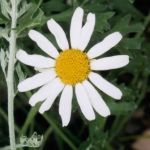| Common Name: |
Dalmation Pellitory |
| Other Names: |
Pyrethrum |
| Botanical Name: |
Tanacetum cinerariifolium syn. Chrysanthemum cinerariifolium, Pyrethrum cinerariifolium |
| Genus: |
Tanacetum |
| Family: |
Asteraceae |
| Native Location: |
Balkans and Albania |
| Cultivation: |
Well-drained to dry, stony soil in sun. Remove dead flower heads or Tanacetum parthenium to prevent excessive self-seeding. Tanacetum vulgare is invasive. |
| Propagation: |
By seed sown at 10-13°C (50-55°F) in spring (species and some variants only); by division in spring or autumn; by basal cuttings in spring; by semi-ripe cuttings in summer. |
| Harvest: |
Whole plants (T. parthenium, T. vulgare) are cut when flowers, and leaves are picked as required, and used fresh or dried in infusions, liquid extracts, powders, and tinctures. Tanacetum vulgare is distilled for oil. Leaves (T. parthenium) are sometimes eaten fresh, or dried for use in tablets to treat migraine, rheumatism, and arthritis. Flowers (T. cinerariifolium are picked as they open and are dried for powder. |
| Height: |
30-75cm (12-30in) |
| Width: |
30cm (12in) |
| Hardiness: |
Z4-9 |
| Parts Used: |
Flowers |
| Properties: |
An aromatic herb with strong insecticidal effects. |
| Ecomonic Uses: |
Dried flowers are used in insectides and fumigants, especially in sprays to control pests and insect-borne diseases in aircraft. |
| Bibliography: |
The Encyclopedia of Herbs by Deni Bown Copyright © 1995, 2001 Dorling Kindersley Limited. pg. 381 |

